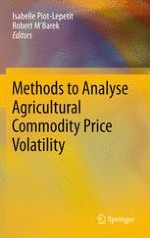2011 | OriginalPaper | Chapter
11. Global Food Commodity Price Volatility and Developing Country Import Risks
Author : Alexander Sarris
Published in: Methods to Analyse Agricultural Commodity Price Volatility
Publisher: Springer New York
Activate our intelligent search to find suitable subject content or patents.
Select sections of text to find matching patents with Artificial Intelligence. powered by
Select sections of text to find additional relevant content using AI-assisted search. powered by
